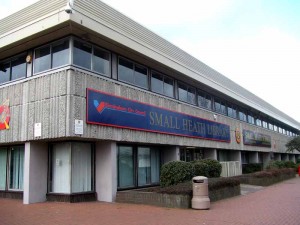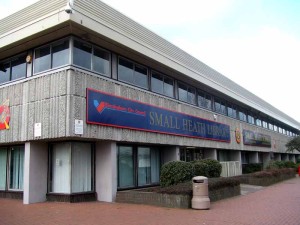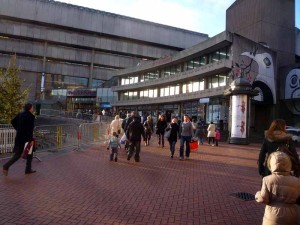Alan Clawley reveals that a Brutalist public library opened in 1977, the foundation stone of which was laid by Harold Wilson in 1975, is not facing demolition.
Other Brutalist buildings all over the country are under threat the future of the Small Heath Library along with the Small Heath School, Leisure Centre and Swimming Pool of which it is an integral part, appears to be secure. The exposed concrete building was designed by the City Architects in the style that was fashionable in the late 60s and is possibly even more Brutalistic than its big sister, the Central Library which the City Council wants to demolish.
There is obviously no question about the future of the buildings as they are fully occupied and well used. The suite of buildings replaced the Victorian Green Lane Baths and Library which themselves have been given a new lease of life as a mosque.
At the time the Small Heath campus was built the idea of putting a public library, a comprehensive school, a leisure centre and a swimming pool under the one roof was quite revolutionary in educational circles but followed the current obsession with ‘rationalisation’, ‘corporate management’ and ‘economy of scale’.
Writing in the ‘Tornado’, the local newspaper in December 1975, Community Education Worker Barry Martin gave it a more human gloss when he said, ‘It will be a Centre with a difference. Certainly a school with a full range of subjects, but also a place where adults can learn, and, even more importantly, a place where we can all share our skills and experience – not to mention have fun. What happens in the Centre will mainly by up to you. The whole idea of Community Education is that the service provides what YOU want, not what THEY think you want. So, it is up to you.’
These high ideals were of course not fully realised. The sharing of reception and building management between several council departments didn’t work for long before separate entrances were made for library, school, leisure centre and community facilities. The school took over the first floor of the library for its own use.
The Community facilities were meant to be managed by a committee of local residents but they couldn’t compete with the professional managers employed by the Council. Departmental budgets were jealously guarded and were continually being cut back. The youth service in particular struggled to keep going in a premises identified by local youth as part of the establishment.
But despite its shortcomings and the general unpopularity of Brutalist architecture there is no pressure either from the Council or the community to sweep it away and replace it with something ‘more suitable for the twenty-first century’. It has survived the first 35 years of its life and has become a vital part of the Small Heath community. There are of course no property developers queuing up to buy it or anyone else wanting to develop the land around it. Unlike most suburban schools this one has no surplus playing fields to dispose of. And even the exposed concrete of its buildings is not seen as a fatal flaw.


